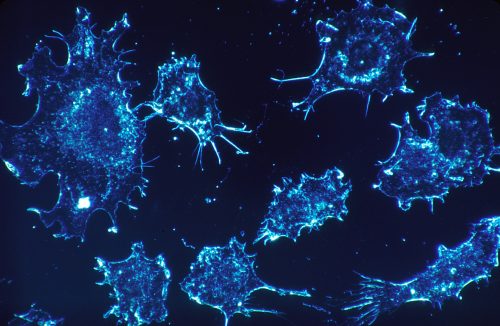Many standard cancer treatments, like radiotherapy and chemotherapy, attempt to create damage in the DNA of cancer cells. Unfortunately, these treatments are often ineffective because cancer cells can respond by activating their DNA repair pathway, allowing them to fix their impaired DNA and continue growing. As a result, many cancer researchers are now developing drugs that specifically inhibit the DNA repair process in cancer cells.
At the Yale Cancer Center, Peter Glazer and his team are studying one such cancer drug: Cediranib. According to Glazer, manipulating DNA repair is a great strategy to boost the effectiveness of conventional cancer therapies. His latest study, which he worked on with Yale MD/PhD student Alanna Kaplan, found that Cediranib can stop certain cancer cells from repairing their DNA. A drug like this can deliver a lethal blow to cancer cells because it leaves them unable to fix the impairment done to their DNA by more traditional cancer treatments. In conjunction with other therapies, Cediranib has the potential to finally put an end to the survival of cancer cells.
Recently, a clinical trial found that Cediranib helped patients with a specific form of ovarian cancer, when used in combination with another drug called Olaparib. The first FDA-approved DNA repair drug on the market, Olaparib specifically inhibits a DNA repair enzyme called poly(ADP-ribose) polymerase, or PARP. The drug Olaparib, on its own, has shown promise in its ability to kill cancer cells that lack pre-existing defects in the DNA repair pathway due to mutations in BRCA1 and BRCA2, two DNA repair genes. Surprisingly the clinical trial discovered that the combination of Olaparib and Cediranib was most effective in patients who did not have BRCA1 or BRCA2 mutations. This finding indicates that the two drugs could work even against cancer cells that did not already have a pre-existing mutation in the DNA repair pathway. Glazer and his team at the Yale Cancer Center wanted to determine how Cediranib exerted such a powerful effect in these patients.
AstraZeneca, a global research-based biopharmaceutical company, originally developed Cediranib to inhibit receptors that stimulate angiogenesis, the process of blood vessel formation. Tumors often require angiogenesis to support growth. Previous researchers had therefore hypothesized that Cediranib was effective because of its function in blocking angiogenesis. If Cediranib were able to block angiogenesis and stop the growth of blood vessels around tumors, the environment inside those tumors would become low-oxygen since blood carries oxygen to cells. A low-oxygen condition, or hypoxia, has been shown to negatively affect the process of DNA repair in cells. Therefore, Glazer hypothesized that Cediranib was effective because it could induce hypoxia inside tumor cells, leading to weak DNA repair.
Glazer and his team confirmed this hypothesis that Cediranib stops the growth of new blood vessels in tumors. However, they were surprised to find that this drug actually had a much more potent effect: Cediranib prevents cells from being able to use a process called homology-directed repair (HDR), through which cells can use an intact DNA strand as a template to repair damaged DNA. Cediranib stops HDR in cells by directly inhibiting receptors involved in cell growth. This unexpected function of Cediranib is entirely independent of its ability to induce tumor hypoxia and inhibit the growth of new blood vessels. When used in treatment alongside Olaparib, Cediranib can entirely stop cancer cells from repairing their DNA at this early stage in the DNA repair process.
“We are now testing whether Cediranib can be used to suppress DNA repair in other types of cancers, besides breast and ovarian cancer,” Glazer said. The researchers hope to broaden the potential of this treatment to other cancer types, and find a more long-lasting cure for individuals fighting cancer around the world.

